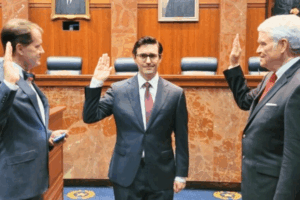Halloween is almost here, and many parents of young children often experience conflicting emotions. They feel the excitement associated with their child dressing up and trick-or-treating. But at the same time, some parents worry that their child will find Halloween too scary.
So what are parents to do? In short, don’t worry too much about it. Kids, even young children, can differentiate fantasy from reality.
Parents often worry that when their children see other children dressed up as scary beings such as witches and monsters, they will think that they are indeed encountering real witches and real monsters, and hence will be terrified and possibly even traumatized.
But research conducted by my colleagues and I shows that, despite occasional errors, children are actually quite good at making the fantasy-reality distinction by the age of 3 or 4. Our research showed that preschool-age children use many of the same cues that adults use to make this distinction.
For example, preschoolers are more likely to think that something is real if a doctor is associated with it versus a dragon. So they pay attention to context. Children also use the presence or absence of evidence to make decisions about what’s real.
Although it may not appear likely to some people, there are potential benefits of putting on a costume. Through pretending to be someone or something else, children can explore alternate identities. They do this by using their imaginations, something that arguably does not get enough exercise anymore in these times of electronic devices.
Are some alternate identities more beneficial than others? My colleagues and I believe that certain types of imagination may have unique benefits for creativity. Some alternate identities are quite realistic, like a firefighter.
Others are way-out fantastical, like a unicorn. We think the in-between level, what we call Fanciful Imagination, has the greatest potential benefit. Children explore identities that are real but unusual, such as a medicine man or a deep-sea diver. We think the unique balance of fantasy and realism at this level may potentially aid creative problem solving.
Parents’ concerns about Halloween are not entirely unfounded however.
Certain things can disrupt children’s ability to figure out what’s real. Experiencing a negative emotion, such as fear, is one. Research also shows that certain children are more likely to believe things are real than others.
In one study, we taught children about a Halloween fantasy figure called the Candy Witch. She visits children’s houses on Halloween night and leaves them a new toy in exchange for candy. We found that some children believed more than others in the real existence of the Candy Witch. Children who already believed in more fantastical beings such as Santa and the Tooth Fairy were more likely to believe in her.
Thus, parents should be aware that children’s grasp of the fantasy-reality distinction might differ, even if they are the same age.
The bottom line for parents is that children can separate fantasy from reality, and that allowing children to dress up for Halloween may have benefits. And there are things parents can do to prevent their children from getting too scared on Halloween.
One is to let them see people putting on their costumes — if they can see the transformation, they will do better than if a costumed person suddenly appears in front of them.
There are also things parents can do if their children do get scared. It’s important to remember that children understand the distinction between fantasy and reality — they just sometimes have trouble keeping it at the forefront of their consciousness.
So all you have to do is remind them, just as adults might remind themselves that the scary movie they are watching isn’t real. Or you can just let them go — let them be scared within reason — because after all, sometimes it’s fun to be afraid on Halloween.
Jacqueline Woolley is a professor and chair of the Department of Psychology who studies children’s understanding of reality at The University of Texas at Austin.
A version of this op-ed appeared in TIME, Austin American Statesman and the Fort Worth Star Telegram.
To view more op-eds from Texas Perspectives, click here.
Like us on Facebook.
Should you let your kids dress up for #Halloween? Yes, because it has benefits says @LiberalArtsUT prof: https://t.co/tL9dTqqofY
— Texas Perspectives (@TexPerspectives) October 30, 2015



